Zaragoza, Spain: The Aragonese Metropolis
As February was making way for March to arrive, I was taking a much-needed break out east from cold and rainy Galicia to…cold and windy Aragón. I wasn’t able to escape winter, but I relished the chance to break free from two months of non-stop rain (literally; it had rained every single day) and to explore another part of Spain just as unique as Galicia.
My first stop was the regional capital, Zaragoza. Pronounced “thah-rah-GO-thah” [θa.ɾaˈɣo.θa], it’s been an major city in the area ever since Roman times, and today, more than half of Aragón’s population calls Zaragoza home, making it Spain’s fifth biggest city. Sitting along the banks of the Ebro River, Zaragoza is about halfway between Madrid and Barcelona with a high-speed train station and an airport to serve its more than 700,000 residents. Most of them are local Aragonese who fled the countryside to find work in the ’60s and ’70s, but quite a few are immigrants from Morocco, Sub-Saharan Africa, China, and Latin America, so the city has a cosmopolitan feel to it not unlike Spain’s two big cities.
Ever since its founding in 14 BCE—named after Caesar Augustus himself—Zaragoza has been an important urban area in eastern part of the peninsula. It’s not surprising at all, then, that Zaragoza has accumulated an impressive monumental heritage over the centuries. Let me share with y’all some of the most interesting corners of the city’s historic core, organized into three major historical periods.
Like most cities that have been continuously inhabited since Roman times, not much remains in Zaragoza from when it was called Caesaraugusta after the Roman emperor. However, over the past few decades, a lot of archaeological work done in the old town has unearthed several key buildings from the Roman era. Walking past a segment of the once-mighty city walls takes you into the grand, spacious Plaza del Pilar (but more on that below). At the other end of this long plaza, you can see the cathedral, but beneath it was once the Roman forum, the ancient city’s civic and religious center. These excavations have only yielded a few pillars and rocky outcroppings, so it was hard to imagine the grand scale of the colonnaded square. But it was cool to crawl around a cloaca, or sewer tunnel.
The ruins of the river port, a bit further inland from the current riverbanks, were a little more substantial. A helpful scale model that tied in with the stones around me helped to imagine a scenario of stairsteps that led down to lapping water. Who knows what sort of spices, oils, or wine would have been carried up and down those steps, or whose weary, sandal-shod feet would have made the hike down to the Hiberus River each day? Very cool.
What little remains of the baths—some steps, tiles, column bases, and a few latrines—weren’t all that impressive, and were rather *ahem* blasé after experiencing the wonders of Pompeii a few months prior. Still, you have to hand it to the zaragozanos for their commitment to uncovering, preserving, and presenting their Roman heritage in such a fine manner.
The real star of the city’s Roman show was the theater. After being abandoned during the Late Roman period, evidence of the theater was lost to time except for the rounded edges of a street here, a house there, and it ultimately became the medieval Jewish quarter. It was rediscovered in the ’70s and excavated over the following decades. While the construction is a bit blurred from the passage of time, and while the seating goes up only half a dozen rows or so, it’s the biggest reminder of Rome’s stamp on Zaragoza.
In the 700s, Muslim armies from North Africa swept across the Strait of Gibraltar and easily conquered the fragile Visigothic kingdom that then controlled the Iberian Peninsula. A new government, based in the southern city of Córdoba, would endure for centuries, but the Caliphate of Córdoba ultimately collapsed into civil war in 1031. The resulting power vacuum gave an opportunity for local strongmen to set up tiny kingdoms across the peninsula called taifas; you had the Taifa of Sevilla, the Taifa of Badajoz, the Taifa of Toledo, etc., all coexisting in an uneasy rivalry for a century or two until the reforming dynasties of the Almoravids and Almohads invaded from Morocco and reunited most of Spain.
It was during the Taifa of Zaragoza that the city’s most dazzling example of Islamic art was constructed—the Aljafería. Named for the Moorish ruler Abu Jaffar al-Muqtadir, this palatial fortress is unique in that it is a rare example from the taifa period of Muslim Spain, as most art and architecture comes down to us either from the Caliphate of Córdoba or the subsequent Almoravid/Almohad dynasties.
The palace was heavily altered over the centuries—first it was the residence of the Aragonese monarchs, then a military citadel—but restorations in the 20th century did an amazing job in returning the Aljafería to its original appearance. Today, behemoth rounded turrets guard the imposing arched walls to the complex, and within, the Courtyard of Santa Isabel recalls the same Paradise that architects in Granada’s Alhambra or Sevilla’s Reales Alcázares tried to recreate. Fantastical white lobed arches dance from column to column at one end of the courtyard, and off to one side, you can peek into a small oratory where the mihrab (niche to orient Muslims to pray toward Mecca) is decorated in the same style as the Mosque-Cathedral of Córdoba.
Although the Kingdom of Aragón grew out of the mountainous north and conquered Zaragoza in 1118, the city’s tradition of Islamic art endured. The authorities let practicing Muslims remain in their kingdom, who were called mudéjar, from the Arabic for “allowed to stay.” From then until 1492, the Mudéjar architectural style flourished exclusively in Spain, a fusion of the contemporary European Gothic style with underlying Islamic forms and techniques. The majority of structures built in this style were churches, which often deceptively appear to be mosques with their minaret-looking bell towers. It’s pretty easy to identify a Mudéjar church because their exterior decorations almost always include brick (arranged in intricate geometric designs) and ceramic tiles, often in the typical eight-pointed star.
The best Mudéjar churches in Zaragoza include the Church of San Gil Abad, the Church of San Pablo, and the east façade of the La Seo cathedral.
Zaragoza has not one but two cathedrals in its city center, but this simply means that the bishop shares his time between both churches. One of these cathedrals, however, is almost always referred to as the Pilar Basilica. Dedicated to Nuestra Señora del Pilar, the church claims a history dating back to Roman times, when, according to legend, the Virgin Mary was translated from Palestine to encourage St. James as he preached the gospel in Roman Hispania. Appearing on a pilar (“pillar”) of jasper, she instructed James (Santiago in Spanish) to construct a chapel in her honor, and the rest, as they say, is history.
Mary, under her title as Our Lady of the Pillar, functions as one of the patron saints of Spain, but because her feast day—October 12th—coincided with the discovery of the Americas by Columbus & co. in 1492, this date serves as a huge celebration for all Spanish-speaking countries around the world: in Spain, it’s the Fiesta Nacional (“National Holiday”), while it’s the Día de la Raza (“Day of the Race”) in Latin America.
The church itself is colossal: this great, many-domed rectangle dominates the historic core, and its four gigantic bell towers can be seen from miles away. The exterior is covered in brick in a nod to Aragón’s tradition of Mudéjar architecture, but the inside is a riot of Baroque opulence as weighty white pillars receive swooping, decorated arches and brilliant, sky-blue paint contrasts with the stark white of the pilasters. Upon entering the church, you’re immediately greeted by the woody fragrance of incense. The basilica’s gargantuan side chapels could dwarf small parish churches, and Byzantine-style pendentive domes balance precariously over the grand interior space. The reputed original pillar is venerated in the Chapel of El Pilar, and you can even go up to an exposed oval to kiss or touch the jasper column.
I really enjoyed taking the elevator to the top of one of the bell towers, skipping over 800 steps and taking in panoramic views of Zaragoza. To the north, foreboding clouds rolled in from the Pyrenees mountains, and before me the Ebro River flowed southeast to the Mediterranean. Beneath the bell tower, colorful zig-zag patterns decorated the ten or so chapel domes. To the south, the city sprawled out from the historic core, and to the east, across the half-kilometer-long Plaza del Pilar, the La Seo Cathedral made its existence known, its single onion-topped bell tower held in friendly rivalry to the basilica across the square.
Although primarily a Gothic construction, La Seo has a Romanesque apse behind the main altar, a Mudéjar eastern wall, and a stately Baroque bell tower and western façade. The name comes from the Aragonese word for “the See” or cathedral seat of the bishop. The cathedral’s interior is a serene, freshly restored forest of Gothic columns and arches. Because it was built as a hallenkirche or “hall church” in which the side aisles are the same height as the central nave, the huge interior space feels even larger beneath the cathedral’s grand, heavenly canopy of a roof. Off in a corner and up some stairs, you can find the Tapestry Museum, which showcases some huge tapices that have been taken care of over the centuries. It’s really amazing how characters and clouds in these rugs-turned-works-of-art were all painstakingly put together with thread…by hand!
Have you ever been to Zaragoza before? What other cities can you think of that so clearly display their millennia-old heritage? Comment below!
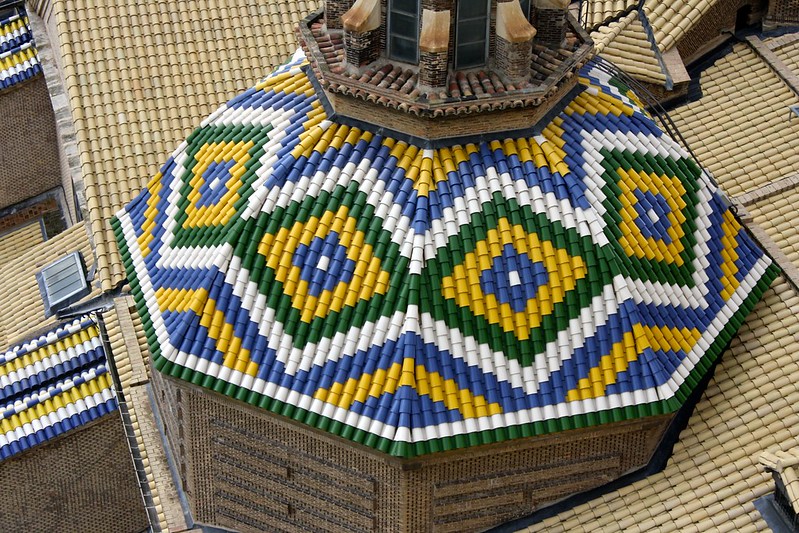
 |
| Pilar Basilica and the Ebro River at the blue hour |
My first stop was the regional capital, Zaragoza. Pronounced “thah-rah-GO-thah” [θa.ɾaˈɣo.θa], it’s been an major city in the area ever since Roman times, and today, more than half of Aragón’s population calls Zaragoza home, making it Spain’s fifth biggest city. Sitting along the banks of the Ebro River, Zaragoza is about halfway between Madrid and Barcelona with a high-speed train station and an airport to serve its more than 700,000 residents. Most of them are local Aragonese who fled the countryside to find work in the ’60s and ’70s, but quite a few are immigrants from Morocco, Sub-Saharan Africa, China, and Latin America, so the city has a cosmopolitan feel to it not unlike Spain’s two big cities.
 |
| The city sprawls out to the north |
Ever since its founding in 14 BCE—named after Caesar Augustus himself—Zaragoza has been an important urban area in eastern part of the peninsula. It’s not surprising at all, then, that Zaragoza has accumulated an impressive monumental heritage over the centuries. Let me share with y’all some of the most interesting corners of the city’s historic core, organized into three major historical periods.
Roman Caesaraugusta
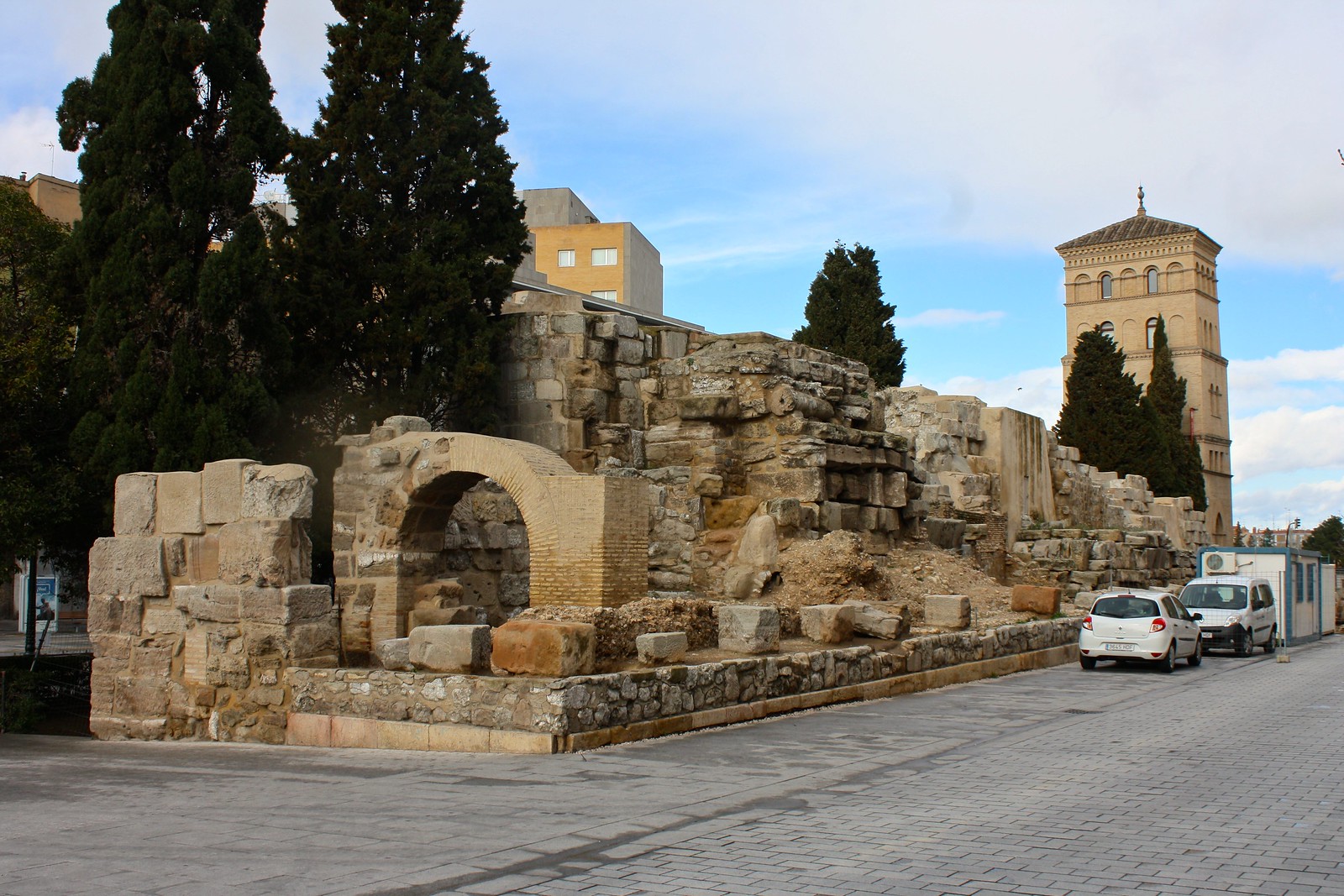 |
| Roman walls |
Like most cities that have been continuously inhabited since Roman times, not much remains in Zaragoza from when it was called Caesaraugusta after the Roman emperor. However, over the past few decades, a lot of archaeological work done in the old town has unearthed several key buildings from the Roman era. Walking past a segment of the once-mighty city walls takes you into the grand, spacious Plaza del Pilar (but more on that below). At the other end of this long plaza, you can see the cathedral, but beneath it was once the Roman forum, the ancient city’s civic and religious center. These excavations have only yielded a few pillars and rocky outcroppings, so it was hard to imagine the grand scale of the colonnaded square. But it was cool to crawl around a cloaca, or sewer tunnel.
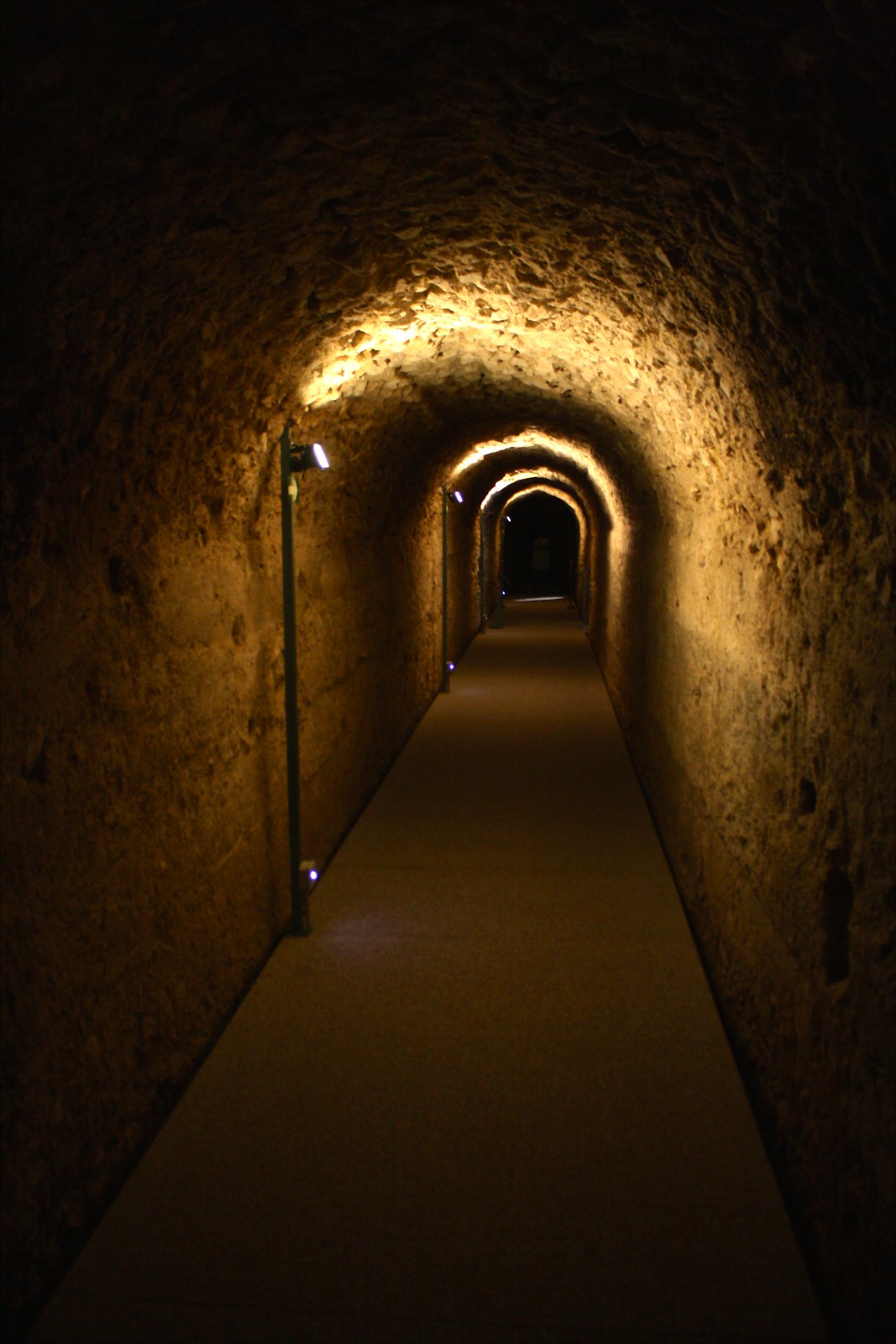 |
| Sewer beneath the forum |
The ruins of the river port, a bit further inland from the current riverbanks, were a little more substantial. A helpful scale model that tied in with the stones around me helped to imagine a scenario of stairsteps that led down to lapping water. Who knows what sort of spices, oils, or wine would have been carried up and down those steps, or whose weary, sandal-shod feet would have made the hike down to the Hiberus River each day? Very cool.
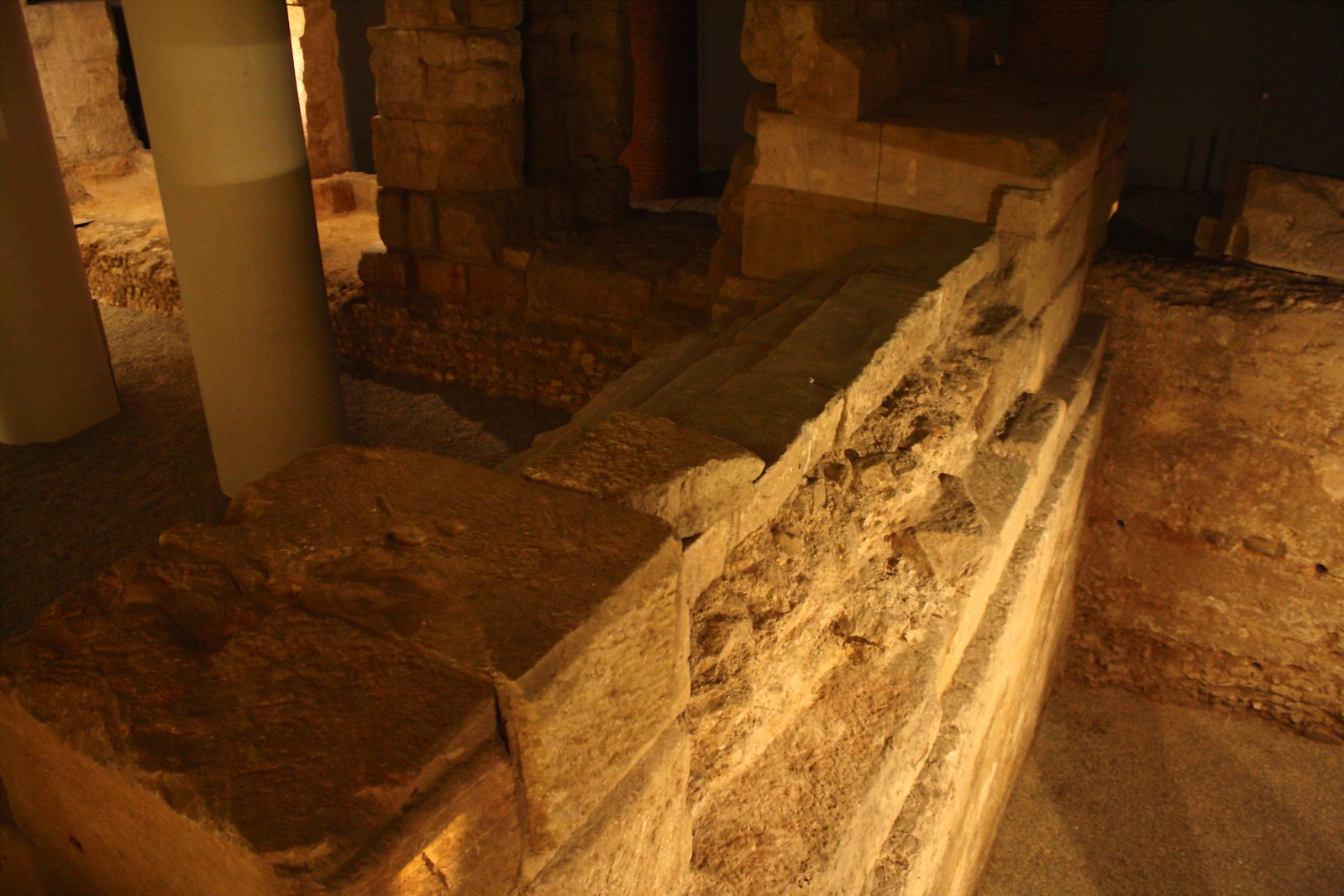 |
| Stairs from the river port |
What little remains of the baths—some steps, tiles, column bases, and a few latrines—weren’t all that impressive, and were rather *ahem* blasé after experiencing the wonders of Pompeii a few months prior. Still, you have to hand it to the zaragozanos for their commitment to uncovering, preserving, and presenting their Roman heritage in such a fine manner.
 |
| The recreated porticoed bath |
The real star of the city’s Roman show was the theater. After being abandoned during the Late Roman period, evidence of the theater was lost to time except for the rounded edges of a street here, a house there, and it ultimately became the medieval Jewish quarter. It was rediscovered in the ’70s and excavated over the following decades. While the construction is a bit blurred from the passage of time, and while the seating goes up only half a dozen rows or so, it’s the biggest reminder of Rome’s stamp on Zaragoza.
 |
| A Roman theater, surrounded by modern apartment blocks |
Muslim Saraqusta
 |
| Entrance gate to the Aljafería palace-castle |
In the 700s, Muslim armies from North Africa swept across the Strait of Gibraltar and easily conquered the fragile Visigothic kingdom that then controlled the Iberian Peninsula. A new government, based in the southern city of Córdoba, would endure for centuries, but the Caliphate of Córdoba ultimately collapsed into civil war in 1031. The resulting power vacuum gave an opportunity for local strongmen to set up tiny kingdoms across the peninsula called taifas; you had the Taifa of Sevilla, the Taifa of Badajoz, the Taifa of Toledo, etc., all coexisting in an uneasy rivalry for a century or two until the reforming dynasties of the Almoravids and Almohads invaded from Morocco and reunited most of Spain.
It was during the Taifa of Zaragoza that the city’s most dazzling example of Islamic art was constructed—the Aljafería. Named for the Moorish ruler Abu Jaffar al-Muqtadir, this palatial fortress is unique in that it is a rare example from the taifa period of Muslim Spain, as most art and architecture comes down to us either from the Caliphate of Córdoba or the subsequent Almoravid/Almohad dynasties.
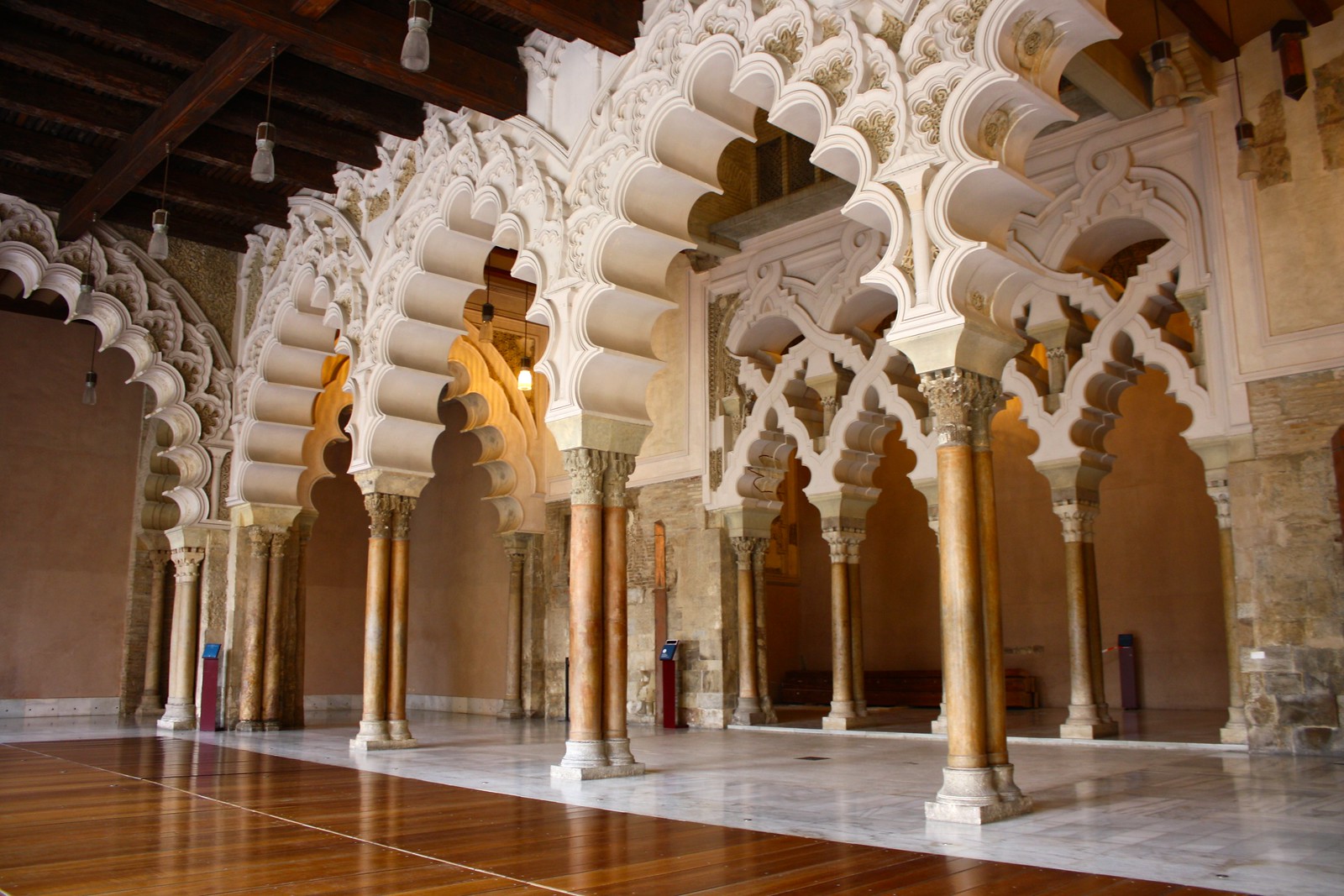 |
| Restored main courtyard of the Aljafería |
The palace was heavily altered over the centuries—first it was the residence of the Aragonese monarchs, then a military citadel—but restorations in the 20th century did an amazing job in returning the Aljafería to its original appearance. Today, behemoth rounded turrets guard the imposing arched walls to the complex, and within, the Courtyard of Santa Isabel recalls the same Paradise that architects in Granada’s Alhambra or Sevilla’s Reales Alcázares tried to recreate. Fantastical white lobed arches dance from column to column at one end of the courtyard, and off to one side, you can peek into a small oratory where the mihrab (niche to orient Muslims to pray toward Mecca) is decorated in the same style as the Mosque-Cathedral of Córdoba.
 |
| Wall of Zaragoza Cathedral |
Although the Kingdom of Aragón grew out of the mountainous north and conquered Zaragoza in 1118, the city’s tradition of Islamic art endured. The authorities let practicing Muslims remain in their kingdom, who were called mudéjar, from the Arabic for “allowed to stay.” From then until 1492, the Mudéjar architectural style flourished exclusively in Spain, a fusion of the contemporary European Gothic style with underlying Islamic forms and techniques. The majority of structures built in this style were churches, which often deceptively appear to be mosques with their minaret-looking bell towers. It’s pretty easy to identify a Mudéjar church because their exterior decorations almost always include brick (arranged in intricate geometric designs) and ceramic tiles, often in the typical eight-pointed star.
 |
| Bell tower of the Church of San Gil Abad |
The best Mudéjar churches in Zaragoza include the Church of San Gil Abad, the Church of San Pablo, and the east façade of the La Seo cathedral.
Christian Çaragoça
 |
| Pilar Basilica, seen from the plaza |
Zaragoza has not one but two cathedrals in its city center, but this simply means that the bishop shares his time between both churches. One of these cathedrals, however, is almost always referred to as the Pilar Basilica. Dedicated to Nuestra Señora del Pilar, the church claims a history dating back to Roman times, when, according to legend, the Virgin Mary was translated from Palestine to encourage St. James as he preached the gospel in Roman Hispania. Appearing on a pilar (“pillar”) of jasper, she instructed James (Santiago in Spanish) to construct a chapel in her honor, and the rest, as they say, is history.
Mary, under her title as Our Lady of the Pillar, functions as one of the patron saints of Spain, but because her feast day—October 12th—coincided with the discovery of the Americas by Columbus & co. in 1492, this date serves as a huge celebration for all Spanish-speaking countries around the world: in Spain, it’s the Fiesta Nacional (“National Holiday”), while it’s the Día de la Raza (“Day of the Race”) in Latin America.
 |
| Inside the Pilar Basilica |
The church itself is colossal: this great, many-domed rectangle dominates the historic core, and its four gigantic bell towers can be seen from miles away. The exterior is covered in brick in a nod to Aragón’s tradition of Mudéjar architecture, but the inside is a riot of Baroque opulence as weighty white pillars receive swooping, decorated arches and brilliant, sky-blue paint contrasts with the stark white of the pilasters. Upon entering the church, you’re immediately greeted by the woody fragrance of incense. The basilica’s gargantuan side chapels could dwarf small parish churches, and Byzantine-style pendentive domes balance precariously over the grand interior space. The reputed original pillar is venerated in the Chapel of El Pilar, and you can even go up to an exposed oval to kiss or touch the jasper column.
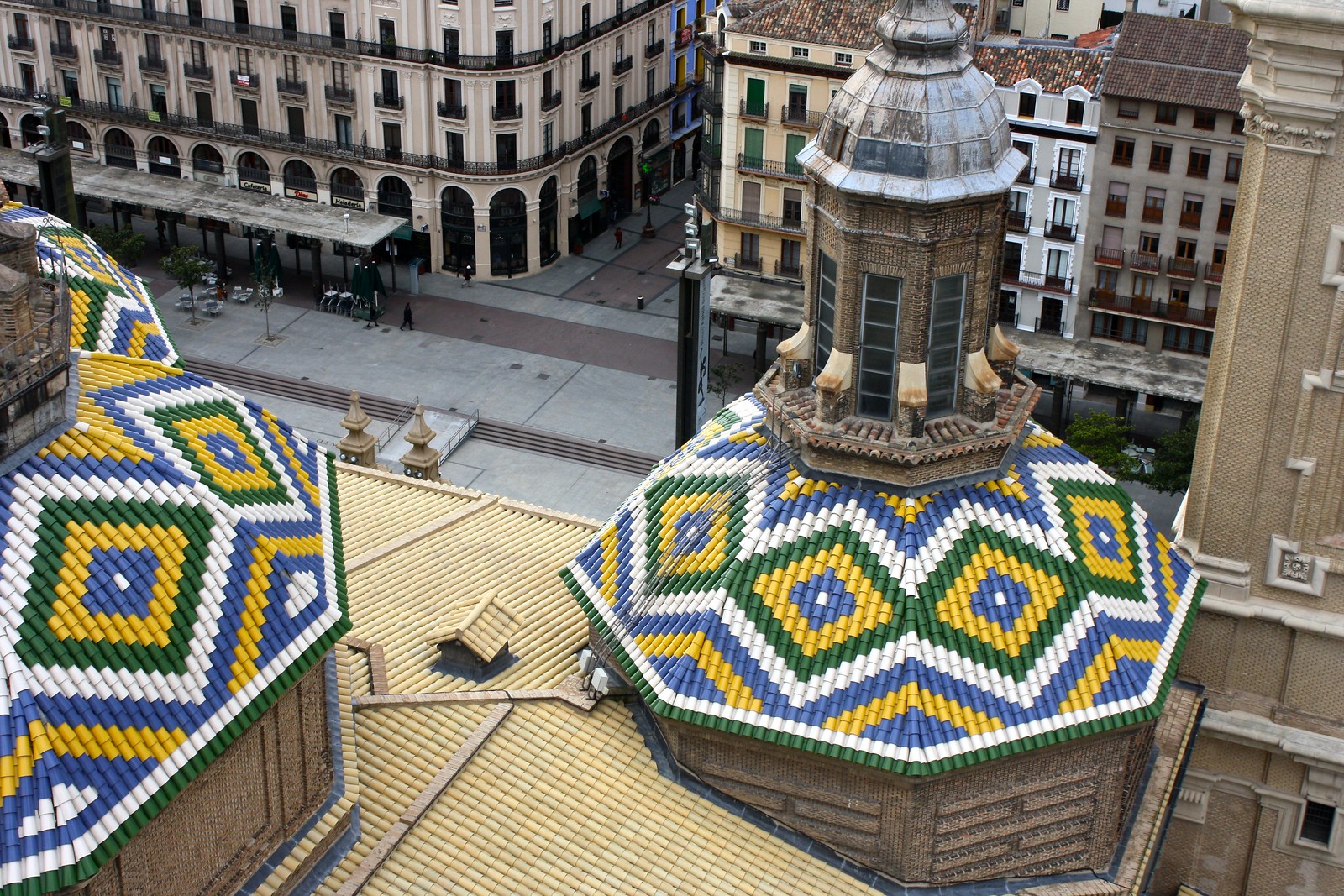 |
| Rooftop tiling |
I really enjoyed taking the elevator to the top of one of the bell towers, skipping over 800 steps and taking in panoramic views of Zaragoza. To the north, foreboding clouds rolled in from the Pyrenees mountains, and before me the Ebro River flowed southeast to the Mediterranean. Beneath the bell tower, colorful zig-zag patterns decorated the ten or so chapel domes. To the south, the city sprawled out from the historic core, and to the east, across the half-kilometer-long Plaza del Pilar, the La Seo Cathedral made its existence known, its single onion-topped bell tower held in friendly rivalry to the basilica across the square.
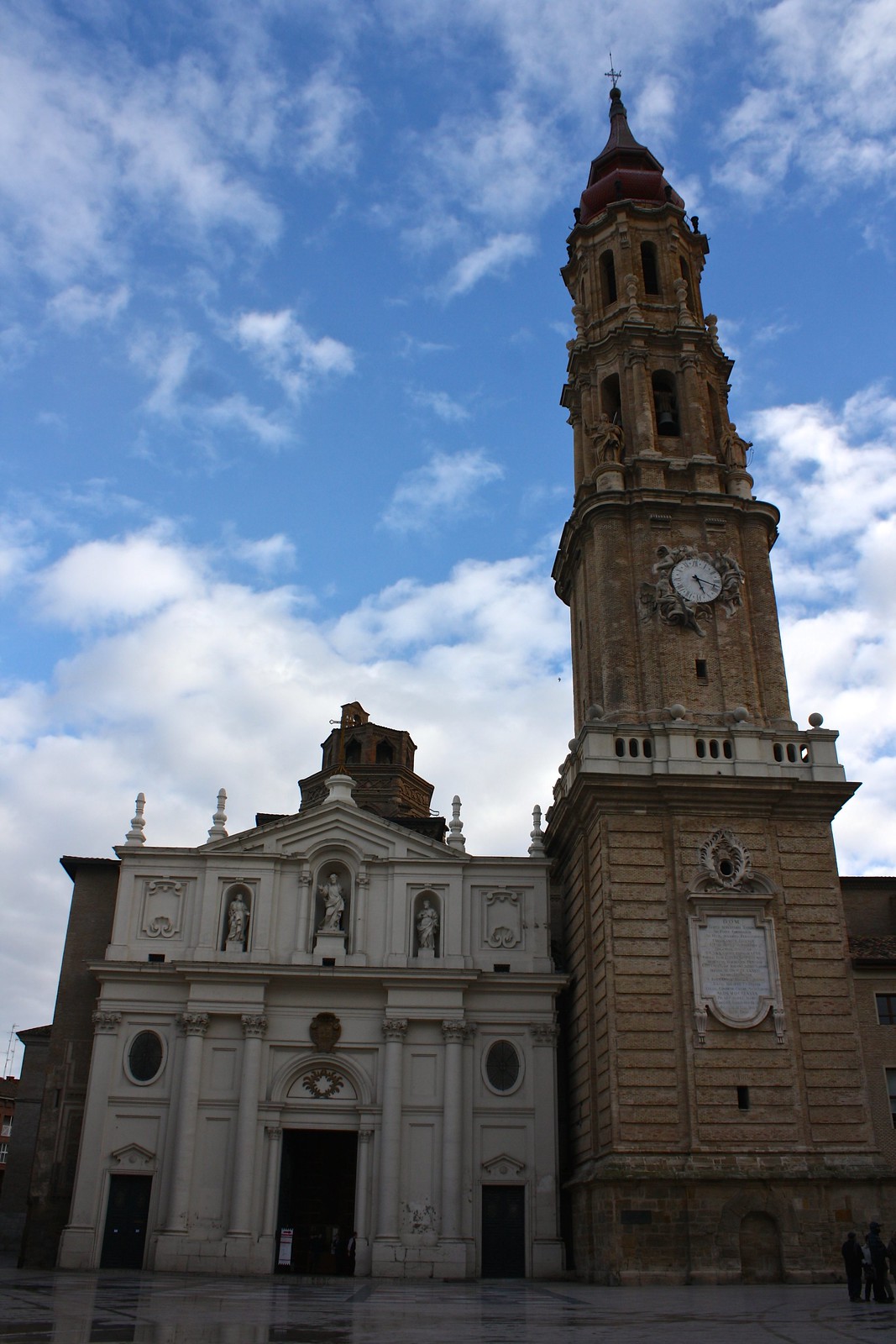 |
| La Seo |
Although primarily a Gothic construction, La Seo has a Romanesque apse behind the main altar, a Mudéjar eastern wall, and a stately Baroque bell tower and western façade. The name comes from the Aragonese word for “the See” or cathedral seat of the bishop. The cathedral’s interior is a serene, freshly restored forest of Gothic columns and arches. Because it was built as a hallenkirche or “hall church” in which the side aisles are the same height as the central nave, the huge interior space feels even larger beneath the cathedral’s grand, heavenly canopy of a roof. Off in a corner and up some stairs, you can find the Tapestry Museum, which showcases some huge tapices that have been taken care of over the centuries. It’s really amazing how characters and clouds in these rugs-turned-works-of-art were all painstakingly put together with thread…by hand!
 |
| Inside the cathedral |
Have you ever been to Zaragoza before? What other cities can you think of that so clearly display their millennia-old heritage? Comment below!
